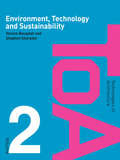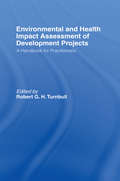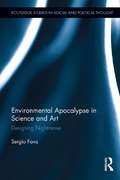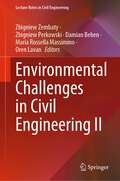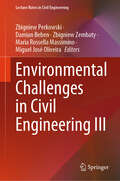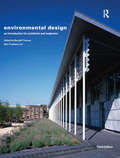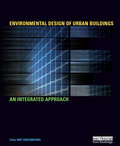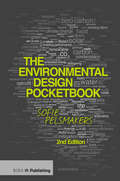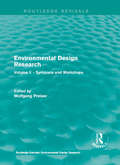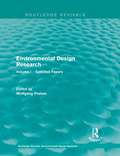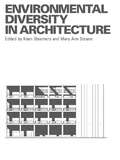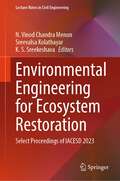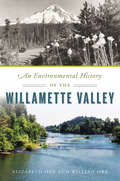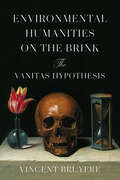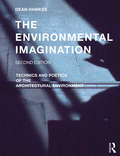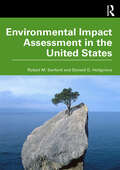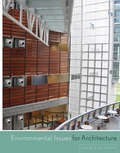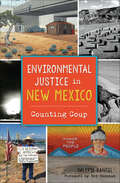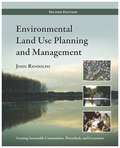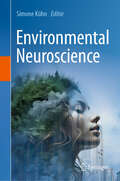- Table View
- List View
Environment, Technology and Sustainability (Technologies of Architecture)
by Hocine Bougdah Stephen SharplesThis second volume in the Technologies of Architecture series – the only series of books tuned to the architectural technology syllabus – explores the environmental influences on building design. Looking particularly at sustainable building, a holistic view is taken, so that the influence of any one set of choices on other areas – such as the trade-off of daylighting against thermal insulation, or the balance needed between heating and ventilation – are not overlooked. The authors discuss available technologies for establishing a suitable microclimate within buildings, for managing the transmission of sound and for minimizing the exploitation of scarce energy and of other resources. Using the perspective of a designer who needs a sound scientific basis for arriving at the optimum outcome, this valuably informative volume is ideal for architectural technology students, as well as first and second year architecture students.
Environmental and Health Impact Assessment of Development Projects: A handbook for practitioners
by The World Health OrganizationThis handbook for practitioners in environmental and public health, environmental management, toxicology and ecotoxicology has been prepared by an international group of experts from both developing and developed countries and covers a wide range of topics in both environmental impact assessment and environmental health impact assessment.
Environmental Apocalypse in Science and Art: Designing Nightmares (Routledge Studies in Social and Political Thought #79)
by Sergio FavaAt a time when it is clear that climate change adaptation and mitigation are failing, this book examines how our assumptions about (valid and usable) knowledge are preventing effective climate action. Through a cross-disciplinary, empirically-based analysis of climate science and policy, the book situates the failures of climate policy in the cultural history of prediction and its interfaces with policy. Fava calls into question the current interfaces between scientific research and climate policy by tracing multiple connections between modelling, epistemology, politics, food security, religion, art, and the apocalyptic. Demonstrating how the current domination of climate policy by models and scenarios is part of the problem, the book examines how artistic practices are a critical location to ask questions differently, rethink environmental futures, and activate social change. The analysis starts with another moment of climatic change in recent western history: the overlap of the Little Ice Age and the "scientific revolution," during which intense climatic, scientific and political change were contemporary with mathematical calculation of the apocalypse. Dealing with the need for complex answers to complex and urgent questions, this is essential reading for those interested in climate action, interdisciplinary research and methodological innovation. The empirical analyses amount to a methodological experiment, across history of science, theology, art theory and history, architecture, future studies, climatology, computer modelling, and agricultural policy. This book is a major contribution to understanding how we are precluding effective climate action, and designing futures that resemble our worst nightmares.
Environmental Challenges in Civil Engineering II (Lecture Notes in Civil Engineering #322)
by Zbigniew Zembaty Zbigniew Perkowski Damian Beben Maria Rossella Massimino Oren LavanThis book gathers a selection of papers presented at the 5th International Scientific Conference “Environmental Challenges in Civil Engineering”, ECCE 2022, held on September 26-28, 2022, in Opole, Poland. Written by an international group of experts, it reports on findings concerning structural material behavior, and new methods and technologies in constructions. A special emphasis is given to sustainable constructions practices, including material recycling and reuse, renovation and restoration of historical building and to those fostering sustainable development of cities and rural areas, and a better integration of buildings with the environment. Offering a good balance of theory and practice, and covering both technical and organizational aspects in civil engineering and architectural projects, this book offers extensive information on solutions and current challenges in construction projects and structural interventions in the context of environmental protection and earthquake prevention.
Environmental Challenges in Civil Engineering III (Lecture Notes in Civil Engineering #615)
by Zbigniew Perkowski Damian Beben Zbigniew Zembaty Maria Rossella Massimino Miguel José OliveiraThis book gathers a selection of papers presented at the 6th International Scientific Conference “Environmental Challenges in Civil Engineering”, ECCE 2024, held on April 22–24, 2024, in Opole, Poland. Written by an international group of experts, it reports on findings concerning structural material behavior, and new methods and technologies in constructions. A special emphasis is given to sustainable constructions practices, including material recycling and reuse, renovation and restoration of historical building and to those fostering sustainable development of cities and rural areas, and a better integration of buildings with the environment. Offering a good balance of theory and practice, and covering both technical and organizational aspects in civil engineering and architectural projects, this book offers extensive information on solutions and current challenges in construction projects and structural interventions in the context of environmental protection, earthquake prevention and sustainable urban planning.
Environmental Design: Architecture, Politics, and Science in Postwar America (Midcentury: Architecture, Landscape, Urbanism, and Design)
by Avigail SachsMuch of twentieth-century design was animated by the creative tension of its essential duality: is design an art or a science? In the postwar era, American architects sought to calibrate architectural practice to evolving scientific knowledge about humans and environments, thus elevating the discipline’s stature and enmeshing their work in a progressive restructuring of society. This political and scientific effort was called "environmental design," a term expanded in the 1960s to include ecological and liberal ideas. In her expansive new study, Avigail Sachs examines the theoretical scaffolding and practical legacy of this professional effort.Inspired by Lewis Mumford’s 1932 challenge enjoining architects to go beyond visual experimentation and create complete human environments, Environmental Design details the rise of modernist ideas in the architectural disciplines within the novel context of sociopolitical rather than aesthetic responsibilities. Unlike today’s "starchitects," environmental designers saw themselves as orchestrators of decision making more than auteurs of form and style. Viewing architectural practice as rooted in Progressive Era politics and the democratic process rather than the European avant-garde, Sachs plots how these social concepts spread via influential architecture schools. This rich examination of pedagogy and practice is a map to both the history of environmental design and the contemporary consequences of architecture understood as a pressing social concern.
Environmental Design: An Introduction for Architects and Engineers
by Randall ThomasWritten and edited by a team of specialists at Max Fordham LLP, one of the UK’s leading environmental and building services engineering consultancies, Environmental Design is the result of their extensive experience in designing environmentally-friendly buildings. The principles of their approach, which they have taught in numerous schools of architecture and engineering, are clearly presented here. The book starts with some basic scientific principles and environmental issues and then moves on to site planning, energy use, materials and building form. Natural ventilation systems, high-efficiency mechanical equipment and alternative energy sources are also covered. State-of-the-art buildings of exceptional quality are incorporated throughout the text and illustrate the authors’ belief that environmentally responsible architecture can be visually exciting. They conclude with a selection of detailed case studies of award-winning projects – including, new for this third edition, Beaufort Court, King's Langley and the National Trust Headquarters, Swindon. This book is essential reading for architects, engineers, planners and students of these disciplines.
Environmental Design of Urban Buildings: An Integrated Approach
by Mat SantamourisThis book provides a review of environmental and energy research with respect to urban building projects. It describes how to overcome related challenges in environmental design of urban buildings. The book discusses the passive and active environmental systems within building concepts.
Environmental Design Perspectives: Viewpoints on the Profession, Education and Research (Routledge Revivals)
by Wolfgang F. E. PreiserThe purpose of this title, first published in 1972, was to bring into focus the work and viewpoints of individuals and groups that were engaged in man-environment research, design and education. Reflecting the multidisciplinary nature of the field of man-environment relations, topics range from aspects of environmental design methodology to research applications from the behavioural sciences. This title will be of interest to students of architecture.
The Environmental Design Pocketbook
by Sofie PelsmakersThe Environmental Design Pocketbook 2nd ed places the information you need for sustainable, low energy building design at your fingertips. Packed with diagrams, tools and tips, it cuts through the complex mass of technical data and legislation that faces the designer, and distils all the key guidance into a single reference that is quick, easy to use and points to the facts, figures and performance data that are most important. This 2nd edition is now fully up-to-date with the latest Building Regulations Part L and F legislation (England and Wales), RIBA Plan of Work 2013, new information on the Green Deal and Zero Carbon and contains revised references and further reading sections throughout. Whether used in the classroom, office or on-site, the book guides the designer through the entire process; from the fundamentals to the building details. From future-proofing for a changing climate to rainwater harvesting, retrofit, and zero-carbon technologies - the Pocketbook has got it covered.
Environmental Design Research: Volume two symposia and workshops (Routledge Revivals: Environmental Design Research)
by Wolfgang PreiserFirst published in 1973, this two-volume set summarises and structures the contributions by researchers at the Fourth International EDRA Conference, held in April 1973. The second volume focuses on the symposia and invited papers, which were theory orientated. The symposia comprehensively assessed the status of contemporary knowledge as well as potential future directions in the respective fields contributing to environmental design research. This volume also provides summaries of the workshops, which explored problem solving processes and offered methodological applications to environmental analysis and other topics of concern. This book will be of interest to students of architecture and design.
Environmental Design Research: Volume one selected papers (Routledge Revivals: Environmental Design Research)
by Wolfgang PreiserFirst published in 1973, this two-volume set summarises and structures the contributions by researchers at the Fourth International EDRA Conference, held in April 1973. The first volume focuses on the proceedings of the paper sessions. It summarises and criticises 43 selected paper submissions which communicate contemporary research findings. It also reviews the discussions between authors, panellists and the session participants. This book will be of interest to students of architecture and design.
Environmental Design Sourcebook: Innovative Ideas for a Sustainable Built Environment
by William McLean Pete SilverHow do we design in a climate emergency? A new social and ecological prerogative demands appropriate material choices, a re-invention of construction and evolving building programmes that look at lifecycle, embodied energy and energy use. Highly illustrated with practical information and simple explanations for design ideas, this book is the perfect introduction to sustainable design for architecture students. It presents key concepts in relation to the embodied energy of construction, material properties and environmental performance of buildings in an accessible way. In explaining the principles and technologies by which we heat, cool, moderate and mitigate, it demystifies environmental design as a technical exercise and enables students to create sustainable buildings with impact. Keep this sourcebook with you. Features: Amphibious House (Baca Architects), Ashen Cabin (HANNAH), Bunhill 2 Energy Centre (Ramboll, Cullinan Studio, McGurk Architects and Colloide), Cork House (Matthew Barnett Howland, Oliver Wilton and Dido Milne), Dymaxion House (Richard Buckminster Fuller), Eastgate Centre (Mick Pearce), Neuron Pod (Will Alsop – aLL Design and AKT II), Quik House (Adam Kalkin) and Tension Pavilion (StructureMode and Weber Industries). Covers: Acoustics, bamboo construction, biopolymer, bioremediation, CLT, climatic envelope, computational fluid dynamics, earthen architecture, fabric formwork, hempcrete, insulation, mycelium biofabrication, paper construction, passive solar heating, pneumatic structures, solar geometry, tensegrity structures, thermal mass and more.
Environmental Diversity in Architecture
by Koen Steemers Mary Ann SteaneThis book takes the position that the dynamic of the architectural environment is a key aspect of good design, yet one which is not well anticipated or understood. Environmental variety is a design characteristic closely related to our experience of architecture - an architecture of the senses. Each chapter demonstrates how an understanding of a particular context or environmental characteristic in dynamic terms informs design. The book is an antidote to the misconceptions of 'optimum' environmental performance or fixed criteria, instead embracing the richness of environmental variety.
Environmental Engineering for Ecosystem Restoration: Select Proceedings of IACESD 2023 (Lecture Notes in Civil Engineering #464)
by N. Vinod Chandra Menon Sreevalsa Kolathayar K. S. SreekeshavaThis book presents select proceedings of the International Conference on Interdisciplinary Approaches in Civil Engineering for Sustainable Development (IACESD 2023) hosted under the aegis of the Group of Twenty (G20) and Civil 20 (C20) at Jyothy Institute of Technology, Bengaluru, India. The topics covered include resilient approaches towards environmental sustainability and combating climate, study of natural hazards and their impacts, resilient infrastructure and land-use planning strategies, climate adaptation and mitigation measures, green infrastructure, coastal protection, and urban heat island reduction. This book serves as a resource material for researchers and industry professionals interested in developing solutions for sustainable and resilient infrastructure that aims for communities with Net Zero Targets.
An Environmental History of the Willamette Valley (Natural History)
by Elizabeth Orr William OrrWestern Oregon's Willamette Basin, once a vast wilderness, became a thriving community almost overnight. When Oregon territory was opened for homesteading in the early 1800s, most of the intrepid pioneers settled in the valley, spurring rapid changes in the landscape. Heralded as fertile with a mild climate and an abundance of natural resources, the valley enticed farmers, miners and loggers, who were quickly followed by the construction of rail lines and roads. Dams were built to harness the once free-flowing Willamette River and provide power to the growing population. As cities rose, people like Portland architect Edward Bennett and conservationist governor Tom McCall worked to contain urban sprawl. Authors Elizabeth and William Orr bring to life the changes that sculpted Oregon's beloved Willamette Valley.
Environmental Humanities in India (Asia in Transition #25)
by Debajyoti Biswas John C. RyanThis open access book offers an introduction to the field of the environmental humanities in India. The environmental humanities, often referred to as ‘EH’, are a multifaceted, relatively new, and swiftly evolving field of scholarship that integrates the theories and approaches of various disciplines - from anthropology, art, communications, cultural studies, philosophy and ecology to history, literature, media, music, performance, politics, sociology, theology and theater. Practitioners of this considerably integrative and widely ranging field aim to address and, in certain cases, confront today's urgent ecological and cultural challenges, namely climate change, urban sustainability, biodiversity conservation, species decline, energy policy, the exigencies of the Anthropocene, environmental activism, and Indigenous peoples' justice. Although the environmental humanities have been relatively slow to gain traction in South Asia, an increasing momentum towards transdisciplinary approaches to ecology and sustainability is palpable in India. Comprising fourteen chapters, this contributed volume is the first major publication to call attention to current work in the environmental humanities in India. The volume foregrounds particular ecohumanist theories and methodologies evolving from Indian biocultural contexts. Towards this aim, the book consists of four thematic sections: Indigenous Perspectives: Conservation, Spirituality, and Language; Theoretical Grounding: Education, Law, and Ethics; Literary Formulations: Memoir, Parable, and Storyworlds; and Popular Narratives: Myth, Travel, and Music. The volume is of interest to undergraduates, postgraduates, early career scholars, and more established researchers in the environmental humanities and the allied fields of ecopoetics, ecocriticism, ecomusicology, environmental art, cultural ecology, postcolonial studies, and South Asian studies. This is an open access book.
Environmental Humanities on the Brink: The Vanitas Hypothesis
by Vincent BruyereIn this experimental work of ecocriticism, Vincent Bruyere confronts the seeming pointlessness of the humanities amid spectacularly negative future projections of environmental collapse. The vanitas paintings of the sixteenth and seventeenth centuries dazzlingly depict heaps of riches alongside skulls, shells, and hourglasses. Sometimes even featuring the illusion that their canvases are peeling away, vanitas images openly declare their own pointlessness in relation to the future. This book takes inspiration from the vanitas tradition to fearlessly contemplate the stakes of the humanities in the Anthropocene present, when the accumulated human record could well outlast the climate conditions for our survival. Staging a series of unsettling encounters with early modern texts and images whose claims of relevance have long since expired, Bruyere experiments with the interpretive affordances of allegory and fairytale, still life and travelogues. Each chapter places a vanitas motif—canvas, debris, toxics, paper, ark, meat, and light—in conversation with stories and images of the Anthropocene, from the Pleistocene Park geoengineering project to toxic legacies to in-vitro meat. Considering questions of quiet erasure and environmental memory, this book argues we ought to keep reading, even by the flickering light of extinction.
The Environmental Imaginary In Brazilian Poetry And Art
by Malcolm K. McneeThis study contributes to ongoing discussions on the connections between the environmental imaginary and issues of identity, place and nation. Utilizing a delimited ecocritical approach, McNee puts Brazilian culture, through the work of contemporary poets and visual artists, into a broader, transnational dialogue.
The Environmental Imagination: Technics and Poetics of the Architectural Environment
by Dean HawkesThe Environmental Imagination explores the relationship between tectonics and poetics in environmental design in architecture. Working thematically and chronologically from the eighteenth century to the present day, this book redefines the historiography of environmental design by looking beyond conventional histories to argue that the environments within buildings are a collaboration between poetic intentions and technical means. In a sequence of essays, the book traces a line through works by leading architects of the nineteenth and twentieth centuries that illustrate the impact of new technologies on the conception and realisation of environments in buildings. In this, a consideration of the qualitative dimension of environment is added to the primarily technological narratives of other accounts. In this second edition, the book has been substantially rewritten and restructured to include further research conducted in the decade since the first edition. A number of important buildings have been revisited, in order to extend the descriptions of their environments, and studies have been made of a number of newly studied, significant buildings. A completely new essay offers an environmental interpretation of Luis Barragán’s magical own house in Mexico City and the earlier studies of buildings by Peter Zumthor have been gathered into a single, extended essay that includes a body of new research. On the fiftieth anniversary of the publication of Reyner Banham’s, The Architecture of the Well-tempered Environment, the book concludes with a critical tribute to that seminal text. The Environmental Imagination will appeal to academics and practitioners with interests in the history, theory and technology of architecture.
Environmental Impact Assessment in the United States
by Robert M. Sanford Donald G. HoltgrieveEnvironmental impact assessment is now firmly established as an important and often mandatory part of proposing any development project. Environmental Impact Assessment in the United States provides foundational knowledge of environmental review in the United States as carried out at federal, state, and local levels, with detailed information about the National Environmental Policy Act (NEPA) and its applications, and other relevant federal and state legislation. This book will aid planners, architects, engineers, project managers, or consultants who work with environmental impact statements to assess the effects of a proposed activity on the environment and who develop and assess measures to avoid or minimize those impacts. It will serve as a desk reference for professional environmental planners as well as a core textbook for students who intend to work in the fields of environmental policy, civil engineering, environmental law, resources management, or other areas of environmental management.
Environmental Issues for Architecture
by David Lee SmithA comprehensive introduction to environmental controls for architectural designWith concerns for sustainability rapidly changing the technological playing field, the romanticized depiction of architects as solitary artists confined to their drafting tables is becoming a thing of the past. More than ever, today's architects must assume a leadership role in collaborative design that involves many professional interactions. This requires that architects have an all-inclusive understanding of the environmental concerns influencing their designs.Comprehensive and broad in scope, this designer-friendly guide delivers solid fundamentals from a historical perspective, covering environmental design topics that range from lighting, acoustics, thermal control, and plumbing to fire protection egress, elevators, and escalators. It shows how the interconnection between science and aesthetics holds the key to creating buildings that are structurally enduring and socially responsible. This book:Gives an understanding of the principles of various environmental issues without getting bogged down in engineering specificsIs illustrated throughout with photographs and drawingsIncludes a companion Web site with PowerPoint presentationsEnables designers to communicate and coordinate effectively with specialists in HVAC, electrical systems, lighting, plumbing, and acousticsEnvironmental Issues for Architecture provides architecture and interior design students with the larger picture without overwhelming them with details. Exploring subjects that are not emphasized in traditional classrooms, this timely book shows how architects and designers can successfully transform their ideas in ways that allow them to expand their professional services and play a more important role in the building process.
Environmental Justice in New Mexico: Counting Coup (Natural History)
by Valerie RangelIn New Mexico and across America, communities of color bear the brunt of contamination from generations of expansion, mining, nuclear testing and illegal dumping. The nation's largest uranium waste spill occurred in 1979 at Church Rock, and radioactivity in the Rio Puerco remains at dangerous levels. The National Trust for Historic Preservation listed Mount Taylor as one of the ten most endangered historic sites in America. After decades of sickness from Rio Grande river water, the first female governor of a Pueblo Nation, Verna Olgin Teller, led tribal members to a Supreme Court victory over Albuquerque. Valerie Rangel presents stories of strife and struggle in the war to protect the integrity of natural systems, rights to religious freedom and the continuation of traditional customs.
Environmental Land Use Planning and Management: Second Edition
by John RandolphSince the first publication of this landmark textbook in 2004, it has received high praise for its clear, comprehensive, and practical approach. The second edition continues to offer a unique framework for teaching and learning interdisciplinary environmental planning, incorporating the latest thinking, newest research findings, and numerous, updated case studies into the solid foundation of the first edition.The book has been reorganized based on feedback from instructors, and contains a new chapter entitled "Land Use, Energy, Air Quality and Climate Change." Throughout, boxes have been added on such topics as federal laws, state and local environmental programs, and critical problems and responses.This new edition addresses three broad subject areas. Part I, "Environmental Planning and Management," provides an overview of the field, along with the fundamentals of land use planning, and presents a collaborative approach to environmental planning. Part II, "Sustainable Land Use Principles and Planning Analysis," considers environmental and geospatial information; soils, topography, and land use; stream flow, flooding, and runoff; stormwater management and stream restoration; groundwater hydrology; landscape ecology; wildlife habitats and biodiversity; energy, air quality and climate change; and methods for land analysis. Part III, "Managing Watersheds, Ecosystems and Development to Achieve Sustainable Communities," explains the principles of ecosystem management, restoration, and protection; land conservation; and the mitigation of natural hazards.With this thoroughly revised second edition, Environmental Land Use Planning and Management maintains its preeminence as the leading textbook in its field.
Environmental Neuroscience
by Simone KühnThis important new book presents an introduction to Environmental Neuroscience, an emerging field devoted to the study of brain-mediated bidirectional relationships between organisms and their physical environments. Environmental Neuroscience offers a novel perspective in the human neurosciences, which have typically focused on the individual isolated from its natural habitat. The book presents the theoretical background of the field, discusses how the environment impacts humans and how humans impact the environment, explores the neuroscience of the built environment, and addresses special populations and presents different methodological approaches. Environmental Neuroscience bringing together the top authorities in the field, will appeal to neuroscientists and to a range of scholars from public health, urban studies, human geography, and architecture who are searching for guidance on what characterizes a health-promoting environment.
